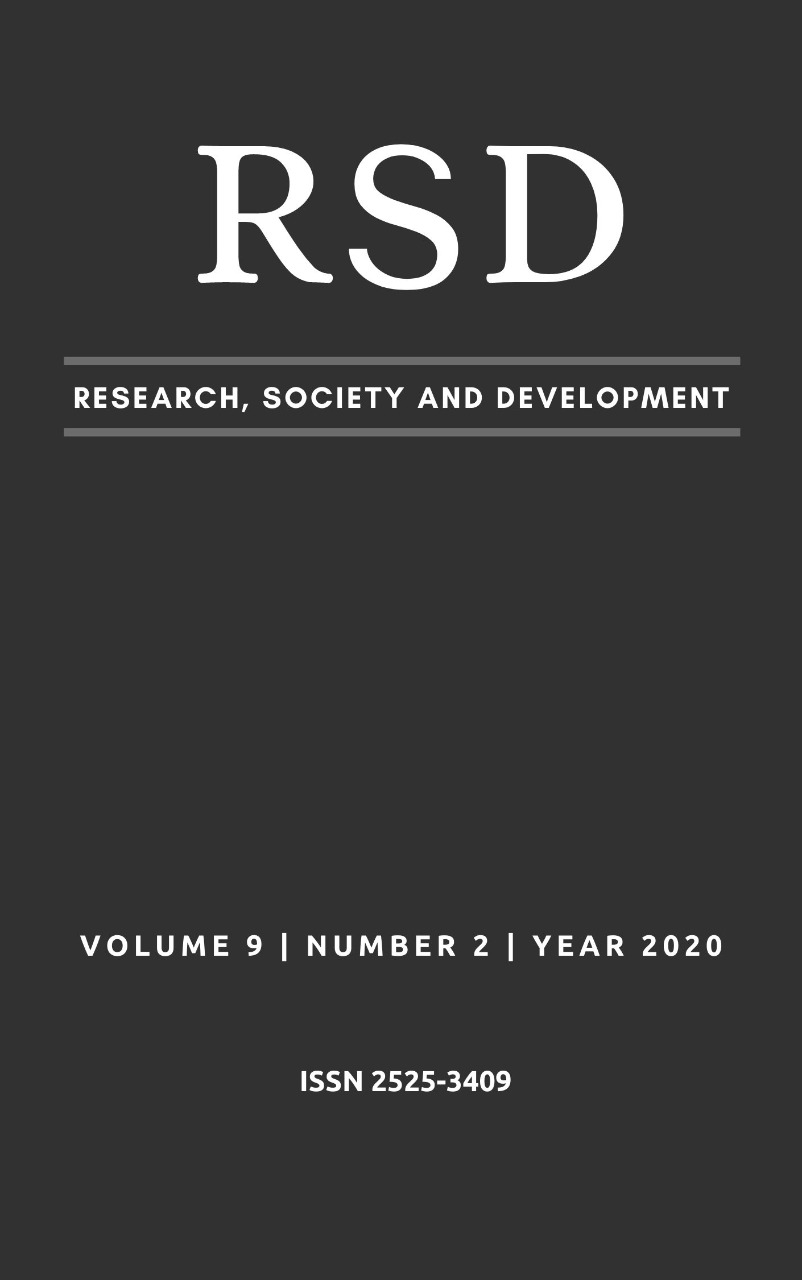Potencial Evocado Auditivo Cognitivo em crianças com transtorno fonológico
DOI:
https://doi.org/10.33448/rsd-v9i2.1982Palavras-chave:
Audição, Criança, Transtorno Fonológico, Potenciais Evocados AuditivosResumo
Analisar se o transtorno fonológico influencia na latência e na amplitude do P300 em crianças. Estudo com caráter transversal, quantitativo, prospectivo. A amostra foi distribuída em dois grupos: grupo com desenvolvimento típico de fala e grupo com transtorno fonológico. O estudo foi dividido nas etapas de recrutamento da amostra, avaliações de fala e avaliação do P300. Utilizaram-se os testes estatísticos adequados. O grupo de crianças com transtorno fonológico apresentou respostas para a variável latência significantemente maiores quando comparado ao grupo com desenvolvimento típico de fala. O transtorno fonológico influenciou na latência do P300 de crianças que apresentam desorganização ou inadequações no sistema fonológico.
Downloads
Referências
American Psychiatry Association. (2013) Diagnostic and Statistical Manual of Mental disorders - DSM-5. 5th.ed. Washington: American Psychiatric Association.
Andrade, CR, . et al. (2004) ABFW: Teste de linguagem infantil nas áreas de fonologia, vocabulário, fluência e pragmática. Pró-Fono Revista de Atualização Cinetífica, 2ª Edição.
Azevedo, MR, Angrisani, RG. Desenvolvimento das Habilidades Auditivas. (2015) In: Boechat, EM, Menezes, PL, Couto, CM, Frizzo, ACF, Scharlach, RC, Anastasio, ART. Tratado de Audiologia. 2ª ed. Rio de Janeiro: Guanabara Koogan; 373-380.
Brancalioni, AR, Bertagnolli, APC, Bonini, JB, Gubiani, MB, Kekse-Soares, M. (2012) A relação entre discriminação auditiva e transtornofonológico. J Soc Bras Fonoaudiol, 24(2),157-161.
Ceron, MI, Gubiani, MB, Oliveira, CR, Keske-Soares, M. (2018) Evidências de validade e fidedignidade de um instrumento de avaliação fonológica. Codas, 30 (3), e20170180.
Ceron, MI, Gubiani, MB, Oliveira, CRD, Gubiani, MB, Keske-Soares, M. (2017) Prevalence of phonological disorders and phonological processes in typical and atypical phonological development. CoDAS, 29(3),e20150306 DOI: 10.1590/2317-1782/20172015306.
Colella- Santos, MF. Processamento Auditivo na Escola. (2015) In: Boechat, EM, Menezes, PL, Couto, CM, Frizzo, ACF, Scharlach,, RC, Anastasio, ART. Tratado de Audiologia. 2ª ed. Rio de Janeiro: Guanabara Koogan; 425- 32.
Ferraz, E, Gonçalves, TDS, Freire, T, Mattar, TLF, Lamônica, DAC, Maximino, LP, Crenitte, AP. (2018) Effects of a Phonological Reading and Writing Remediation Program in Students with Dyslexia: Intervention for Specific Learning Disabilities. Folia Phoniatr Logop., 70(2), 59-73. doi: 10.1159/000489091
Ferreira, L, Gubiani, MB, Keske-Soares, M, Skarzynski, PH, Sanfins, MD, Biaggio, EPV. (2019) Analysis of the components of Frequency-Following Response in phonological disorders. Int J Pediatr Otorhinolaryngol.,122,47-51. doi: 10.1016/j.ijporl.2019.03.035.
Gonçalves, IC, Wertzner, HF, Samelli, AG, Matas, CG. (2011) Speech and non-speech processing in children with phonological disorders: an electrophysiological study. Clinics, 66(2),293-298.
Iliadou, VV, Chermak, GD, Bamiou, DE. (2015) Differential Diagnosis of Speech Sound Disorder (Phonological Disorder): Audiological Assessment beyond the Pure-tone Audiogram. J Am Acad Audiol., 26(4),423-435. doi: 10.3766/jaaa.26.4.9.
Leite, RA, Wertzner, HF, Gonçalves, IC, Magliaro, FCL, Matas, CG. (2014) Auditory evoked potentials: predicting speech therapy outcomes in children with phonological disorders. Clinics, 69 (3), 212-218.
Leite, RA, Wertzner, HF, Matas, CG. (2010) Potenciais evocados auditivos de longa latência em crianças com transtorno fonológico. Pró-Fono Revista de Atualização Científica, 22(4),561-566.
McPherson, DL. (1996) Late potentials of the auditory system. San Diego: PublishingGroup; 7-46.
Melo, A, Mezzomo, CL, Garcia, MV, Biaggio EPV. (2016) Effects of computerized auditory training in children with auditory processing disorder and typical and atypical phonological system. AudiolCommun Res, 21,e1683. http://dx.doi.org/10.1590/2317-6431-2016-1683.
Melo, A, Mezzomo, CL, Garcia, MV, Biaggio, EPV. (2017) Computerized Auditory Training in Students: Electrophysiological and Subjective Analysis of Therapeutic Effectiveness. Int Arch Otorhinolaryngol, 21 (1), 23-32. DOI https://doi.org/10.1055/s-0037-1600121.
Musiek, FE, Baran, JA, Pinheiro, ML. (1994) Behavioral and electrophysiological test procedures. In: Musiek FE, Baran JA, Pinheiro ML. Neuroaudiology: case studies. 1ª ed. San Diego: Singular Publishing Group; 7-28.
Oliveira, JC, Murphy, CFB, Schochat, E. (2013) Auditory processing in children with dyslexia: electrophysiological and behavior evaluation. CoDAS, 25(1), 39-44.
Regaçone, SF, Gução, ACB, Giacheti, CM, Romero, ACL, Frizzo, ACF. (2014) Long latency auditory evoked potentials in students with specific learning disorders. Audiol Commun Res, 19(1),13-18.
Reis, ACMB, Frizzo, ACF. Potencial Evocado Auditivo Cognitivo. (2015) In: Boechat, EM, Menezes, PL, Couto, CM, Frizzo, ACF, Scharlach, RC, Anastasio, ART. Tratado de Audiologia. 2ª ed. Rio de Janeiro: Guanabara Koogan;140-150.
Rosado, IM, Donicht, G, Simoni, SDN, Pagliarin, KC, Keske-Soares, M. (2017) Perception of the intelligibility and severity level of speech sound disorders by speech language pathologists and non-professionals. Revista CEFAC, 19 (2), 233-241. doi.org/10.1590/1982-0216201719215916
Simões, HO, Frizzo, ACF, Zanchetta, S, Hyppolito, MA, Reis, ACMB. (2016) Variables in P300 recording: task type and electrode position. CoDAS, 28 (4),355-361. DOI: 10.1590/2317-1782/20162015189.
Souza, J, Rocha, VO, Berticelli, AZ, Didoné, DD, Sleifer, P. (2017) Auditory Latency Response – P3 in children with and without learning complaints. Audiol Commun Res, 22:e1690. doi.org/10.1590/2317-6431-2016-1690.
Waring, R. and Knight, R. (2013), How should children with speech sound disorders be classified? A review and critical evaluation of current classification systems. International Journal of Language & Communication Disorders, 48, 25–40. doi:10.1111/j.1460-6984.2012.00195.x
Włodarczyk, E, Szkiełkowska, A, Pilka, A, Skarżyński, H. (2018) Assessment of cortical auditory evoked potentials in children with specific language impairment. Otolaryngol Pol, 72(1),16-22. doi: 10.5604/01.3001.0011.5933.
Zillioto, KN, Kalil, DM, Almeida, CIR. SSI em português. (1997) In: Pereira, LD, Schochat, E. Processamento auditivo central: Manual de avaliação. São Paulo: Lovise, 113-28.
Downloads
Publicado
Edição
Seção
Licença
Autores que publicam nesta revista concordam com os seguintes termos:
1) Autores mantém os direitos autorais e concedem à revista o direito de primeira publicação, com o trabalho simultaneamente licenciado sob a Licença Creative Commons Attribution que permite o compartilhamento do trabalho com reconhecimento da autoria e publicação inicial nesta revista.
2) Autores têm autorização para assumir contratos adicionais separadamente, para distribuição não-exclusiva da versão do trabalho publicada nesta revista (ex.: publicar em repositório institucional ou como capítulo de livro), com reconhecimento de autoria e publicação inicial nesta revista.
3) Autores têm permissão e são estimulados a publicar e distribuir seu trabalho online (ex.: em repositórios institucionais ou na sua página pessoal) a qualquer ponto antes ou durante o processo editorial, já que isso pode gerar alterações produtivas, bem como aumentar o impacto e a citação do trabalho publicado.


